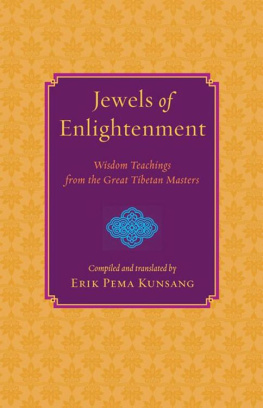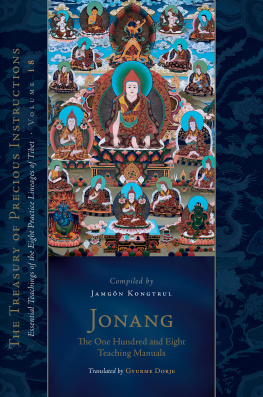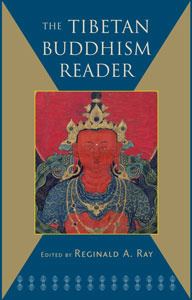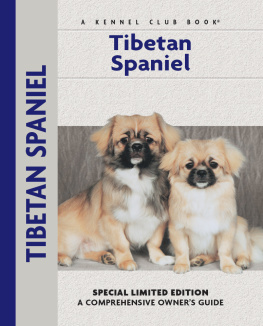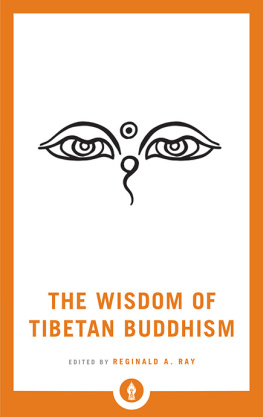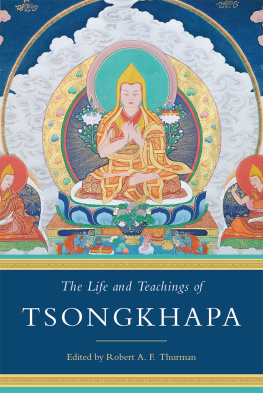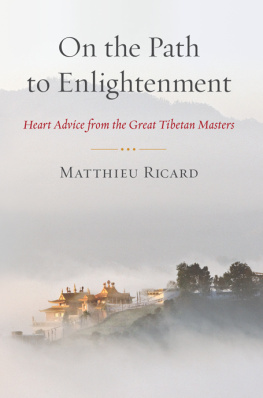This collection of teachings is like myriad beams of light that illuminate each step we take on the path toward awakening.
Matthieu Ricard, author of On the Path to Enlightenment
ABOUT THE BOOK
Delve into Tibets rich religious heritage with this compilation of Buddhist prayers, poems, and teachings from all the various schools. A perfect companion for meditation and contemplation, Jewels of Enlightenment represents over a millennium of wisdom from masters such as Milarepa, Gampopa, Machig Labdrn, Jigmey Lingpa, Shabkar, Jamgn Kongtrl, and more on how to live a meaningful life.
ERIK PEMA KUNSANG is a dharma teacher and one of the worlds most accomplished translators of Buddhist literature from Tibet. He is the cofounder of Rangjung Yeshe Publications, an independent publisher of Vajrayana Buddhist texts in English, and the author of many books, including Blazing Splendor , Gateway to Knowledge , The Light of Wisdom , Wellsprings of the Great Perfection , and Treasures from Juniper Ridge . He is also a board member of 84000, a major project to translate all the words of the Buddha into English. For more information, visit www.erikpemakunsang.com.
Sign up to receive weekly Tibetan Dharma teachings and special offers from Shambhala Publications.

Or visit us online to sign up at shambhala.com/edharmaquotes.
Jewels of Enlightenment
WISDOM TEACHINGS FROM THE GREAT TIBETAN MASTERS
Compiled and translated by
ERIK PEMA KUNSANG
EDITED BY
Marcia Binder Schmidt & Michael Tweed

SHAMBHALA
Boston & London
2015
SHAMBHALA PUBLICATIONS, INC.
Horticultural Hall
300 Massachusetts Avenue
Boston, Massachusetts 02115
www.shambhala.com
2003 by Erik Hein Schmidt
Ornaments used throughout courtesy of Robert Beer .
This book was originally published under the title A Tibetan Buddhist Companion .
All rights reserved. No part of this book may be reproduced in any form or by any means, electronic or mechanical, including photocopying, recording, or by any information storage and retrieval system, without permission in writing from the publisher.
LIBRARY OF CONGRESS CATALOGING-IN-PHBLICATION DATA
Tibetan Buddhist companion
Jewels of enlightenment: wisdom teachings from the great Tibetan masters/compiled and translated by Erik Pema Kunsang; edited by Marcia Binder Schmidt & Michael Tweed.
pages cm
eISBN 978-0-8348-0044-1
ISBN 978-1-59030-179-1 (pbk.)
1. BuddhismChinaTibet RegionDoctrines. 2. Buddhism Quotations, maxims, etc. 3. Spiritual lifeBuddhism. I. Kunsang, Erik Pema, editor, translator. II. Schmidt, Marcia Binder, editor. III. Tweed, Michael, editor. IV. Title.
BD7604.T53 2015
294.3444dc23
2014033659
All the teachings given by the Buddha have but a single purpose: to benefit sentient beings. This benefit can be the temporary peace and happiness among gods and human beings, or it can be the lasting good of liberation and enlightenment.
JAMGN KONGTRL THE GREAT
Contents
T HE PRECIOUS TEACHINGS of Buddha Shakyamuni arrived on the Tibetan plateau in the sixth century and have survived there ever since. Under the patronage of Tibets kings, Buddhist teachers were invited from countries near and far; of these countries, present-day India is regarded as the mother source. It is often said that the inaccessibility of Tibet, with its snowy mountain ranges, helped to secure a purity of teaching and practice up until recent times. Yet another major factor in retaining such purity is the sincerity that is embodied in the basic Buddhist principles of renunciation, bodhichitta , devotion, and the true view.
Many countries have been blessed by the instructions of the Awakened One, and Buddhism in its various lines of transmission is branded and categorized accordingly. Thus, people today speak of Tibetan Buddhism.
From the Tibetan point of view, there are as many approaches, or vehicles, as there are different types of people, while practically speaking there are three main approaches: Hinayana, Mahayana, and Vajrayana. It does not make sense to claim that one is higher or better than another. Most important is what an individual needs in order to progress from wherever he or she is at this very moment. The three vehicles share the perspective that allows that to happenhow to remove what hinders liberation and enlightenment, how to create the right circumstances to progress, and how to gain further experience and realization.
The common approach in each case is to identify the main culprit: our ignorance, which allows selfishness expressed in emotions and actions. The three vehicles taught by the Buddha are more precious than anything else we could possibly find or achieve in this world because on every level they provide practical and realistic tools for dealing with any situation. The knowledge of how to remove ignorance and selfishness is the most valuable gift we could receivedont you agree? Ignorance and selfishness are the cause of so much suffering, while their opposites, wisdom and compassion, are the source of all happiness and well-being. This is the most profound meaning of healing.
If I were to choose the primary characteristic that defines Tibetan Buddhism, it would be its vast variety of approaches and levels of profundity. Tibetan Buddhist masters have emphasized that there is neither conflict nor contradiction between any of the three vehicles, and encouraged an understanding that encompasses all three vehicles. In the words of Tulku Urgyen Rinpoche, Practice the three vehicles in the same session, on the same seat.
The following precious and practical quotes are in harmony with this perspective. They reflect the immense variety of approaches and levels of profundity that have made the tapestry of Tibetan Buddhism a deep interest and daily practice of an ever-increasing number of spiritual seekers the world over. In selecting these quotes, I have focused on unifying all the teachings into a single system. This is how most great masters understand them, as well as how I myself have been taught.
If you are interested in the plight of the Tibetans, here is a selection of valid reasons for preserving their rich cultural heritage.
If you are attracted to the beauty of Tibet, here is the landscape of their profound religion, like a range of immaculate snow mountains reflecting the sunlight of wisdom and compassion with the purity of noble intentions.
If you are looking for insight and the meaning of life, here are drops scooped up from enlightenments inexhaustible ocean.
These quotes are true jewels, and their beauty transcends that of silver, gold, and precious gemstones. String them together on the cord of your daily life.
Let them sparkle!
I WOULD LIKE TO INTRODUCE this selection of precious quotes as practical guidance on how to live a meaningful life. They are offered simply and clearly, in the style employed by my own Buddhist teachers.
Indulge me here.
We usually wake up in the morning from a mentally absent state, having been oblivious to our surroundings, lost in sleep and dreams. The first conscious moment is a questioning: Where am I? Oh, yes, this is where I slept. Many hours have passed, but I feel rested now. Now habits activate us. We begin to do what we are used to doing, seeing things as before, continuing in the same tracks of old aims and pursuits. We become pleased, we become sad, we get angry, attached, upset, happy, irritated. We care, we get careless, caught up, satisfied, spaced out, fed up, interested, and uninterested. The hours fly by. We get tired, then we go to sleep again.
Next page
